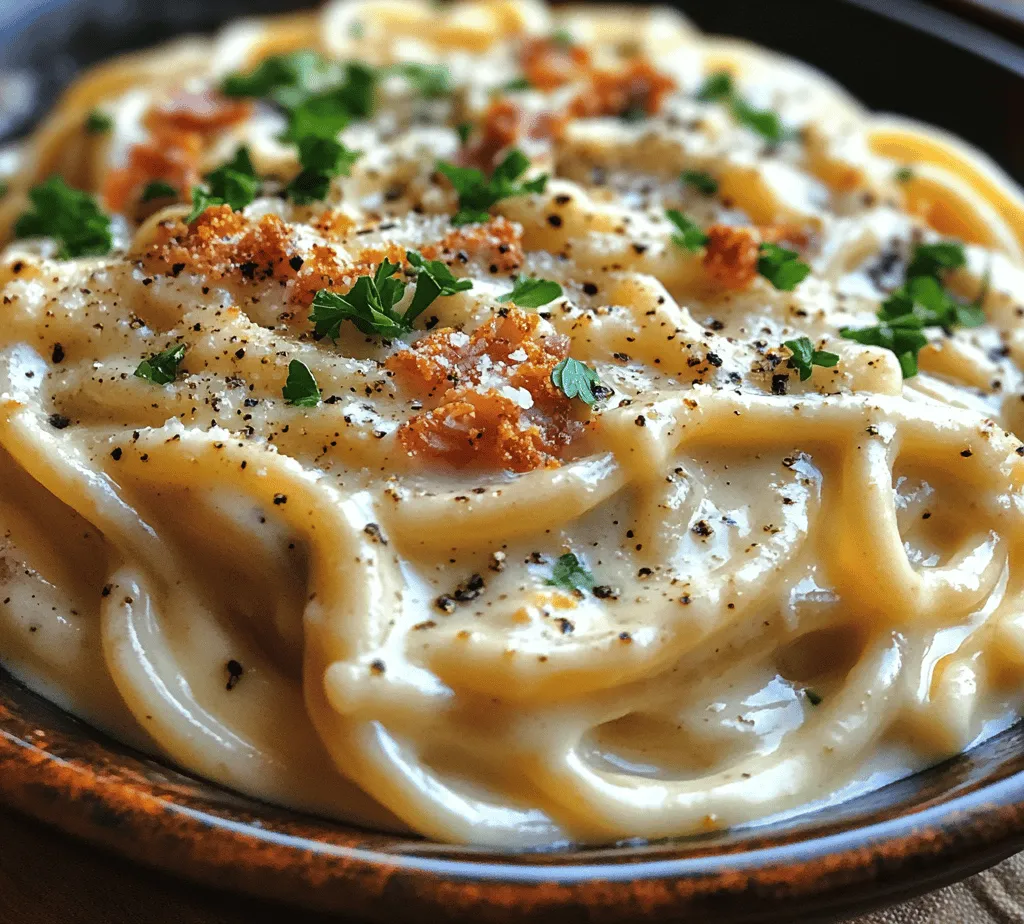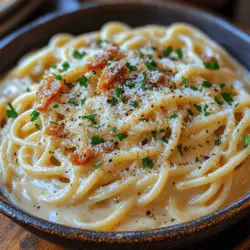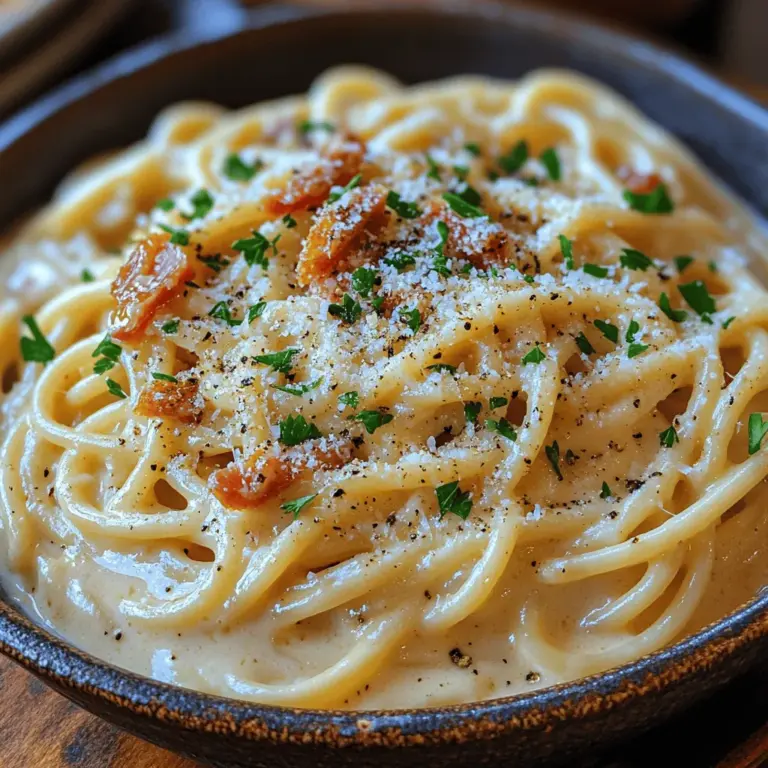Introduction
Spaghetti Carbonara is a beloved Italian dish that has transcended borders to become a staple in kitchens around the world. Known for its rich, creamy sauce and savory flavors, this pasta dish is not just a meal; it’s an experience that embodies the essence of Italian cooking. The beauty of Spaghetti Carbonara lies in its simplicity, yet it demands authenticity in both ingredients and preparation methods to truly shine.
The allure of Carbonara is that it can be served for any occasion, whether it’s a cozy dinner at home, an elegant gathering with friends, or even a festive holiday feast. Its creamy texture, combined with the salty crunch of guanciale, creates a comforting dish that warms the heart and satisfies the palate. In this article, we will delve into the history, ingredients, and preparation techniques that make the Best-Ever Spaghetti Carbonara a recipe worth mastering.
Understanding Spaghetti Carbonara
Historical Background of the Dish
The origins of Spaghetti Carbonara are somewhat shrouded in mystery, with various theories about how this dish came to be. One popular belief is that it was created by Italian charcoal workers, known as “carbonari,” who would prepare a simple meal using readily available ingredients. The dish gained popularity in the mid-20th century, particularly after World War II, when American soldiers stationed in Italy created their own versions using bacon and eggs, which further popularized the dish.
Today, Spaghetti Carbonara is celebrated for its traditional preparation methods and the use of high-quality ingredients. It has become a symbol of Italian culinary heritage, cherished not only in Italy but also around the globe.
Regional Variations in Italy
While the classic Roman version of Spaghetti Carbonara is the most widely recognized, there are regional variations that reflect local ingredients and culinary traditions. In Rome, for instance, the use of guanciale (cured pork cheek) is standard, lending a unique flavor and texture to the dish. In contrast, some regions may opt for pancetta, which is more commonly available outside of Italy.
Furthermore, variations may include the addition of cream, although purists argue that true Carbonara should never contain cream, relying solely on the emulsion of eggs and cheese for its creamy consistency. This debate adds to the charm and complexity of Spaghetti Carbonara, as it showcases the diverse interpretations of Italian cuisine.
Key Characteristics that Define Authentic Carbonara
Authentic Spaghetti Carbonara is defined by a few key characteristics that set it apart from other creamy pasta dishes. First and foremost, the sauce should achieve a silky smooth texture, created by the combination of eggs and cheese. The dish should also highlight the flavor of the guanciale, which should be crisped to perfection, providing a delightful contrast to the creamy sauce.
Another defining aspect of Carbonara is the balance of flavors. The salty richness of the guanciale, the sharpness of the Pecorino Romano cheese, and the freshness of cracked black pepper all come together to create a harmonious dish that is both satisfying and indulgent. Understanding these characteristics is essential to crafting the Best-Ever Spaghetti Carbonara.
Essential Ingredients for the Best Carbonara
To prepare the Best-Ever Spaghetti Carbonara, it’s essential to use traditional ingredients that stay true to the dish’s roots. Here’s a closer look at the key components that will elevate your Carbonara to new heights.
Overview of Traditional Ingredients
1. Spaghetti: The foundation of the dish, spaghetti is the preferred pasta type for Carbonara. Its shape allows the creamy sauce to cling beautifully, ensuring every bite is flavorful.
2. Guanciale: This cured pork cheek is the star ingredient of Carbonara. Its rich flavor and fatty texture provide depth to the dish. If guanciale is unavailable, pancetta can be used as a substitute, though it will alter the flavor profile slightly.
3. Pecorino Romano Cheese: This sharp, salty cheese is crucial for achieving the authentic taste of Carbonara. It melts beautifully, creating a creamy sauce when combined with the egg mixture.
4. Eggs: Fresh eggs are essential for creating the luscious sauce. The yolks contribute richness, while the whites add structure. The quality of the eggs you choose will significantly impact the final dish.
5. Black Pepper: Freshly cracked black pepper adds warmth and a hint of spice, enhancing the overall flavor of the dish. It should be used generously for that classic Carbonara kick.
Importance of Guanciale vs. Pancetta
While both guanciale and pancetta are delicious, they differ significantly in flavor and texture. Guanciale, made from pork cheek, is fattier and richer, lending a more complex flavor to the dish. Pancetta, made from pork belly, is leaner and has a slightly different taste. For the best results, seek out guanciale when making Spaghetti Carbonara, as it represents the authenticity of the dish.
The Role of Pecorino Romano Cheese in Flavor and Texture
Pecorino Romano cheese is not just a simple topping for your Carbonara; it plays an integral role in creating the creamy sauce. Its sharpness balances the richness of the guanciale and eggs, while its ability to melt seamlessly contributes to the smooth texture of the dish. For the best flavor, opt for high-quality, freshly grated Pecorino Romano.
The Significance of Egg Quality in Achieving Creaminess
When it comes to the eggs in your Carbonara, quality matters. Fresh, organic eggs will yield a richer flavor and creamier texture. The yolks should be vibrant in color, indicating a healthy diet for the hens. Whisking the eggs with the grated cheese creates a smooth mixture that will coat the pasta beautifully, ensuring a perfect emulsion when combined with the hot spaghetti.
Optional Enhancements: Garlic and Fresh Herbs
While traditional Spaghetti Carbonara is quite simple, some cooks like to add a touch of garlic or fresh herbs for an extra layer of flavor. A clove of garlic can be sautéed in the guanciale fat, infusing the dish with a subtle aroma. Fresh herbs like parsley or basil can also be sprinkled on top for a touch of color and freshness. However, it’s important to use these enhancements sparingly to maintain the authenticity of the dish.
Preparing for Success: Ingredient Preparation
Before diving into the cooking process, proper ingredient preparation is key to achieving the Best-Ever Spaghetti Carbonara. Here are the detailed steps to ensure you’re set up for success.
Detailed Steps on Measuring and Prepping Ingredients
1. Measure Your Ingredients: Start by measuring out your ingredients to ensure you have everything ready. For a standard serving, you’ll need approximately 400 grams of spaghetti, 150 grams of guanciale, 100 grams of Pecorino Romano cheese, and 3 large eggs.
2. Prep the Guanciale: Cut the guanciale into small cubes or strips, about 1 cm thick. This size allows for even cooking and ensures that the fat renders properly, creating a crispy texture.
3. Grate the Cheese: Using a microplane or box grater, grate the Pecorino Romano cheese. It’s best to grate it fresh, as pre-grated cheese often contains anti-caking agents that can affect melting.
4. Whisk the Eggs: In a mixing bowl, crack the eggs and whisk them together until well combined. Add half of the grated Pecorino Romano and a generous amount of freshly cracked black pepper. Whisk until you have a smooth mixture.
Importance of Achieving the Right Size for Guanciale
The size of the guanciale is important for both texture and flavor. If cut too small, it may become overly crispy and lose its rich, fatty texture. If cut too large, it may not render enough fat to integrate into the sauce properly. Aim for bite-sized pieces that will crisp up nicely while still maintaining some chew.
Tips for Whisking Eggs and Cheese to Create a Smooth Mixture
To ensure a smooth sauce, it’s vital to whisk the eggs and cheese thoroughly. Use a fork or whisk to break up the yolks and combine them with the cheese evenly. This mixture should be creamy and lump-free, as any lumps will not blend well with the pasta. Taking the time to achieve a smooth consistency will result in a velvety sauce that coats the spaghetti perfectly.
Cooking the Spaghetti to Perfection
Cooking the spaghetti is a crucial step in making the Best-Ever Spaghetti Carbonara, as the pasta serves as the base for the creamy sauce. Here are some essential tips to ensure your spaghetti is cooked to perfection.
Importance of Salt in Pasta Water and Its Effects on Flavor
When boiling your spaghetti, the water should be generously salted. A common rule of thumb is to use about 1-2 tablespoons of salt per 4-6 quarts of water. This step is vital, as it enhances the flavor of the pasta itself, allowing the final dish to be well-seasoned. Remember, the pasta will absorb some of the salt during cooking, so don’t skip this step.
Timing: How to Achieve Al Dente Pasta Every Time
Cooking spaghetti to the perfect al dente texture is essential for Carbonara. This means the pasta should be cooked until it is tender but still has a slight bite. To achieve this, check the packaging for cooking times and set a timer for a minute or two less than the recommended time. Taste the pasta as it cooks, and once it reaches al dente, immediately drain it, reserving a cup of the starchy pasta water.
Tips for Reserving Pasta Water for Sauce Consistency
The reserved pasta water is a key element in achieving the desired consistency for your Carbonara sauce. The starches in the water help bind the sauce to the pasta, creating a creamy texture. When you’re ready to combine the spaghetti with the sauce, gradually add the reserved pasta water to achieve the perfect creaminess. Start with a small amount and adjust as needed until you reach your desired consistency.
With these foundational steps, you are well on your way to mastering the art of Spaghetti Carbonara. In the next part of this article, we will dive into the cooking process itself, where the magic of combining these carefully prepared ingredients transforms into a delicious, creamy delight that will surely impress anyone who takes a bite.

Sautéing the Guanciale: The Flavor Base
To begin crafting the best-ever Spaghetti Carbonara, the first step is to sauté the guanciale, which is essential for building a rich flavor base. Guanciale, an Italian cured meat made from pork cheek or jowl, has a higher fat content than other cured meats like pancetta or bacon, making it ideal for this dish.
Optimal Cooking Techniques for Guanciale
Begin by slicing the guanciale into small strips or cubes, about 1/4 inch thick. This size allows for even cooking and helps render the fat effectively. Heat a large skillet over medium heat and add the guanciale to the pan without any additional oil; the fat from the meat will provide sufficient grease for cooking.
Cook the guanciale slowly, allowing the fat to render out and the meat to turn golden brown and crispy. This process should take about 5 to 7 minutes. Avoid rushing this step, as a slower cook will enhance the flavors and result in a perfectly crispy texture.
Understanding the Rendering Process and Achieving Crispiness
Rendering is the process of melting down the fat. As the guanciale cooks, the fat will begin to liquefy, creating a flavorful oil in which to finish cooking the rest of your ingredients. To achieve the ideal crispy guanciale, refrain from overcrowding the pan. If necessary, use two pans to ensure that the pieces have enough space. When the guanciale is done, it should be crispy yet slightly chewy—this textural contrast is key to a delicious Carbonara.
The Optional Use of Garlic: When to Add and When to Remove
Garlic can enhance the flavor of your guanciale, but it should be used judiciously. If you choose to include it, add a whole clove (unpeeled) to the pan once the guanciale begins to crisp. This will infuse a subtle garlic flavor into the fat without overpowering the dish. Remove the garlic clove before combining the guanciale with the pasta, ensuring that the garlic’s flavor remains present but not overwhelming.
Creating the Creamy Sauce
Now that you have your crispy guanciale ready, it’s time to create the creamy sauce that will elevate your Spaghetti Carbonara to a whole new level.
Techniques for Combining Pasta and Guanciale Effectively
Once your spaghetti is cooked al dente (usually about 8-10 minutes in boiling salted water), reserve about a cup of the pasta water before draining. Add the drained spaghetti directly to the skillet with the guanciale, ensuring to turn off the heat before combining. This is crucial, as direct heat could scramble the eggs in the next step.
Gently toss the spaghetti and guanciale together, allowing the fat from the guanciale to coat the pasta. The residual heat will help prepare for the next step without cooking the egg mixture prematurely.
Understanding the Role of Residual Heat in Cooking the Eggs
In a separate bowl, whisk together your eggs and cheese mixture (traditionally, a mix of pecorino Romano and Parmigiano-Reggiano). As you whisk, you want to create a smooth, creamy consistency that will emulsify with the pasta. It is essential to work quickly during this step; the residual heat from the pasta will gently cook the eggs, creating a silky sauce without turning them into scrambled eggs.
Adjusting Sauce Thickness with Reserved Pasta Water for Desired Creaminess
As you combine the egg and cheese mixture with the pasta, if the sauce seems too thick, gradually add some reserved pasta water, a few tablespoons at a time. This step will help achieve a luscious, creamy sauce that clings to each strand of spaghetti. Keep in mind that the key is to maintain a balance; you want the sauce to be creamy but not watery.
The Art of Seasoning
Seasoning plays a vital role in enhancing the flavors of your Spaghetti Carbonara, and achieving the perfect balance is essential.
Importance of Freshly Cracked Black Pepper
One of the defining features of a classic Carbonara is the generous use of freshly cracked black pepper. This ingredient adds a delightful kick that complements the richness of the sauce. Use a pepper mill to grind your black pepper just before serving, ensuring it’s fresh and aromatic. A good rule of thumb is to add it to taste, starting with a few cracks and adjusting as necessary.
Balancing Flavors with Cheese and Seasoning Adjustments
The cheese mixture already adds a salty, nutty flavor, so be careful not to over-salt your dish. Taste your pasta before adding additional salt. The combination of guanciale and cheese often provides ample seasoning. Adjust the amount of cheese or black pepper based on your personal preferences, as everyone has different tastes when it comes to seasoning.
Understanding Personal Preferences in Spice and Flavor Intensity
Flavor intensity can vary widely from person to person. Some may prefer a stronger pepper flavor, while others may enjoy a creamier, milder sauce. Don’t hesitate to experiment with the amounts of black pepper and cheese. Cooking is about personal expression, so feel free to adjust the ingredients to suit your palate.
Plating and Presentation
The way you present your Spaghetti Carbonara can elevate the dining experience, turning a simple dish into an impressive creation.
Techniques for Elegant Plating of Spaghetti Carbonara
When it comes to plating, aim for an elegant presentation. Twirl the spaghetti using a fork or tongs to create a nest-like shape in the center of the plate. This method not only looks appealing but also makes it easier for your guests to enjoy the dish.
The Role of Garnishes: Parsley and Additional Cheese
To finish, sprinkle fresh parsley on top for a pop of color and a hint of freshness. You can also add extra grated cheese at this point to enhance the dish’s richness. A light dusting of black pepper over the top adds a final touch of sophistication.
Tips for a Visually Appealing Presentation
Consider serving your Spaghetti Carbonara in a warm bowl or plate to keep the dish at the ideal temperature. For an extra touch, you could serve it alongside a simple green salad or garlic bread, making for a complete meal that is visually stunning and delicious.
Common Mistakes to Avoid
While making Spaghetti Carbonara may seem straightforward, a few common pitfalls can lead to undesirable results.
Overcooking the Eggs and Sauce
One of the most significant mistakes is overcooking the eggs, leading to a scrambled texture rather than a creamy sauce. Remember to turn off the heat before adding the egg mixture to the pasta and work quickly to combine everything.
Using the Wrong Type of Meat or Cheese
Using substitutes that don’t closely resemble guanciale or traditional Italian cheeses can drastically change the taste of your dish. Stick to authentic ingredients whenever possible to maintain the integrity of the Carbonara.
Not Reserving Enough Pasta Water
Failing to reserve sufficient pasta water is another common error. The starchy water is crucial for adjusting the sauce’s consistency. Always set aside more than you think you’ll need to ensure you can achieve that creamy, luscious texture.
Conclusion
Making the best-ever Spaghetti Carbonara is not just about following a recipe; it’s about embracing the joy of cooking and the richness of Italian culinary tradition. Each step—from sautéing the guanciale to creating the creamy sauce and perfecting your plating—allows you to express your culinary creativity while respecting the origins of this beloved dish.
As you prepare your Carbonara, consider exploring variations that suit your tastes while honoring the traditional elements that make this dish so special. Whether you’re preparing it for a cozy weeknight dinner or a gathering with friends, Spaghetti Carbonara is sure to impress and satisfy. Enjoy the process, and savor each bite of this creamy delight.


